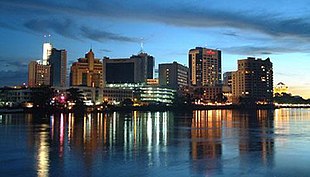 | |
| Currency | Malaysian ringgit (MYR) |
|---|---|
| Calendar year[1] | |
| Statistics | |
| Population | 2.56 million (2020)[2] |
| GDP | |
| GDP rank | 4th out of 15 states in Malaysia (including two federal territories)[3] |
GDP growth | |
GDP per capita | |
GDP per capita rank | 3rd out of 15 states in Malaysia (including two federal territories)[4] |
GDP by sector |
|
| 1.9% (first quarter of 2022)[5] | |
Population below poverty line |
|
| 0.387 (2019)[6] | |
| 0.737 (2021)[7] | |
Labour force |
|
Labour force by occupation |
|
| Unemployment | 3.3% (second quarter of 2022)[8] |
| External | |
| Exports | RM 100,591 million (2019)[10] |
Export goods |
|
Main export partners |
|
| Imports | RM 41,120 million (2020)[12] |
Import goods |
|
Main import partners |
|
FDI stock | RM 28.2 billion (2022)[13] |
| Public finances | |
| Revenues | RM 13.3 billion (2023)[14] |
| Expenses | RM 11.5 billion (2023)[15] |
| |
All values, unless otherwise stated, are in US dollars. | |
The economy of Sarawak is the fourth-largest of the states of Malaysia, making up 9.3% of the Malaysian gross domestic product (GDP) in 2022.[3] Meanwhile, Sarawak is home to 7.9% of the Malaysian population (2.56 million out of 32.4 million people in Malaysia) based on the 2020 census.[2][18]
Sarawak economy has traditionally heavily depended on natural resource extraction and exports, including oil and gas, timber and palm oil. These commodities still produce a significant proportion of Sarawak's gross domestic product.[19] Main trade partners of Sarawak are: Peninsular Malaysia, China, and Japan.[11]
- ^ Ten, Marilyn (27 May 2022). "Sarawak's financial accounts accorded clean certificate for 19 consecutive years". The Borneo Post. Archived from the original on 23 June 2022. Retrieved 25 June 2022.
- ^ a b How Pim, Lim (16 June 2022). "Sarawak's population rises to over 2.56 mln in 2020". The Borneo Post. Archived from the original on 18 June 2022. Retrieved 25 June 2022.
- ^ a b c d e Cite error: The named reference
Stats 2022was invoked but never defined (see the help page). - ^ a b Cite error: The named reference
Sarawak 2020was invoked but never defined (see the help page). - ^ Ten, Marilyn (26 May 2022). "Deputy Premier: Sarawak's economy expected to grow up to 6 pct this year". The Borneo Post. Archived from the original on 15 June 2022. Retrieved 28 June 2022.
- ^ a b "Household income and basic amenities survey report by state and administrative district" (PDF). Department of Statistics, Malaysia. Archived from the original (PDF) on 18 February 2022. Retrieved 28 June 2022.
- ^ "Subnational HDI (v5.0) - Malaysia". Global Data Lab. Archived from the original on 29 June 2022. Retrieved 29 June 2022.
- ^ a b "Unemployment rate stabilises in Q2 22". New Sarawak Tribune. 21 November 2022. Retrieved 27 June 2023.
- ^ "Employment by Industry". Sarawak Data. Archived from the original on 1 July 2022. Retrieved 1 July 2022.
- ^ a b "Sarawak Exports By Commodity Sections_2020p". Sarawak Data - State Planning Unit. Archived from the original on 30 June 2022. Retrieved 30 June 2022.
- ^ a b c Tuah, Yvonne (29 September 2019). "Enhancing access to Sarawak's trade". The Borneo Post. Archived from the original on 7 June 2021. Retrieved 19 June 2022.
- ^ a b "Sarawak Import By Commodity Section_December 2020". Sarawak Data - State Planing Unit. Archived from the original on 1 July 2022. Retrieved 1 July 2022.
- ^ "Malaysia attracted RM264.6b approved investments in 2022". The Malaysian Reserve. 8 March 2023. Archived from the original on 22 March 2023. Retrieved 23 February 2024.
- ^ "Abang Johari: Sarawak revenue for 2023 hits RM13.3 bln". The Borneo Post. 12 January 2024. Retrieved 23 February 2024.
- ^ "Premier unveils largest Sarawak Budget of RM12.363 bln, projects RM12.749 bln revenue in 2024". DayakDaily. 20 November 2023. Retrieved 23 February 2024.
- ^ "Moody's upgrades Sarawak's rating to stable, affirms A3 rating". The Malay Mail. 24 September 2021. Archived from the original on 29 September 2021. Retrieved 24 April 2022.
- ^ Cite error: The named reference
MIDA 2019was invoked but never defined (see the help page). - ^ "Census 2020: Bumiputera population increases to almost 70pct". Malaysiakini. 14 February 2022. Archived from the original on 15 February 2022. Retrieved 2 August 2023.
- ^ Lau, Rachel (5 May 2019). "Bolstering Sarawak's trade outlook". The Borneo Post. Archived from the original on 12 June 2021. Retrieved 19 June 2022.